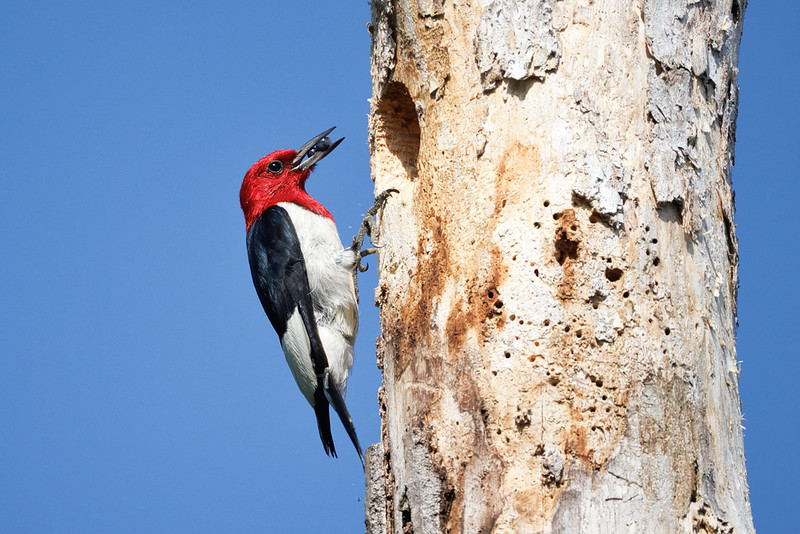In this blog post, we will shine a spotlight on the Red-headed Woodpecker (Melanerpes erythrocephalus) and explore the reasons why they make exceptional dads. Accompanying this discussion is a heartwarming photograph captured at the Sequoyah National Wildlife Refuge in Oklahoma, showcasing a devoted Red-headed Woodpecker bringing berries to the nest hole to feed its hungry young.

- Nurturing Nature: The Red-headed Woodpecker takes its role as a father seriously, exhibiting remarkable nurturing instincts. From incubation to feeding, these dedicated fathers are actively involved in every aspect of parenthood. They participate equally in nest building, brooding the eggs, and rearing the young, creating a strong and supportive foundation for their family.
- Teamwork and Cooperation: Fatherhood is a partnership for Red-headed Woodpeckers. Both parents work together harmoniously to care for their offspring. However, it can be challenging to distinguish between the male and female Red-headed Woodpeckers visually. Their plumage is very similar, making it difficult to discern their gender solely based on appearance. Regardless of their sex, these woodpeckers establish a balanced and cooperative parental dynamic.
- Reliable Providers: When it comes to feeding their young, Red-headed Woodpecker fathers display remarkable dedication and resourcefulness. The featured photograph showcases a woodpecker diligently bringing berries to the nest hole, ensuring that the chicks receive the nourishment they need to grow and thrive. This demonstrates the unwavering commitment these fathers have to meeting the needs of their offspring.
- Fierce Protectors: The Red-headed Woodpecker also serves as a fierce guardian of its family. The parent, regardless of gender, fearlessly defends the nesting site against intruders and predators, ensuring the safety of its mate and their young. Through vocalizations and displays of aggression, it sends a clear message that the nest is off-limits to any potential threats.
- Teaching Life Skills: Red-headed Woodpeckers play an essential role in teaching their offspring crucial life skills. As the young birds mature, the parents gradually introduce them to foraging techniques, help them develop their flight capabilities, and impart knowledge about navigating their environment. These lessons set the foundation for the juveniles’ future independence.
Conclusion:
Fatherhood in the animal kingdom is as diverse as it is awe-inspiring. The Red-headed Woodpecker stands out as an exemplary dad, demonstrating unwavering commitment, nurturing instincts, and remarkable cooperation. While it may be challenging to tell the difference between male and female Red-headed Woodpeckers visually, their shared responsibilities and devotion to their young remain unchanged. This Father’s Day, let us appreciate the dedication and hard work of these remarkable fathers. The photograph captured at the Sequoyah National Wildlife Refuge serves as a reminder of the beauty of nature and the invaluable lessons we can learn from observing the behavior of the animal world.
I would like to express my heartfelt gratitude to my dear friend Mia McPherson from On The Wing Photography for inspiring me to write about the Red-headed Woodpecker’s exceptional fatherhood for Father’s Day. Mia’s passion for wildlife photography and her deep understanding of avian behavior have always been a source of inspiration for me. Her suggestion to focus on the devoted parenting skills of these remarkable woodpeckers has allowed me to shed light on the beauty of nature’s fatherly love. Thank you, Mia, for your invaluable contribution and continuous support in capturing the wonders of the natural world through our lenses.
Equipment Used:
- Camera: Canon EOS R5
- Lens: Canon RF 800 mm F11
Technical Details:
- Location: Sequoyah National Wildlife Refuge (Oklahoma)
- Date and Time Taken: June 17, 2023 (08:16 A. M.)
- Aperture: f11 (Fixed)
- Shutter speed: 1/800
- ISO: 800 (Auto)
- Exp. Comp.: +0.7
- Focal Length: 800 mm (Fixed)
